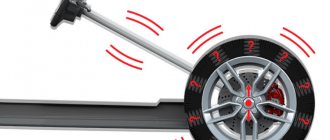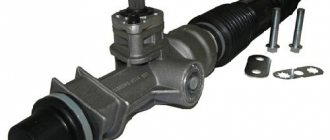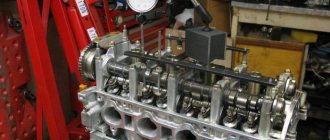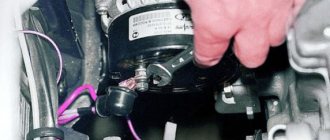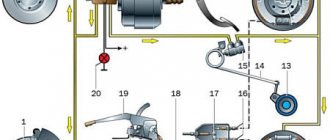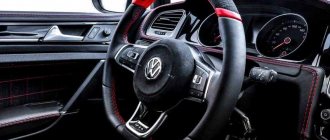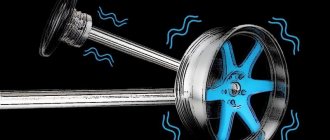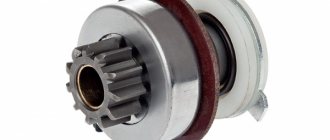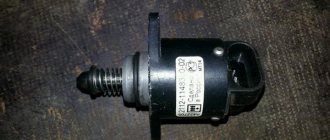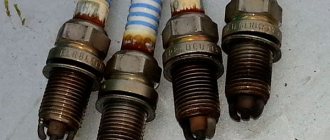It's no secret that you need to take care of your car. When internal systems do not work properly, an unpleasant phenomenon can occur in which the steering wheel begins to vibrate during the operation of the braking system. Such circumstances greatly interfere with movement. The sensation of beating occurs, as a rule, due to impacts or deformation of the discs. One way or another, the damage needs to be fixed.
Find out the cost of diagnosing the brake system online in 3 minutes Don't waste your time - use the Uremont search and get offers from nearby services with specific prices!
Get prices
Causes of steering wheel beating when braking
The reasons may be different:
- damaged bracket for motor support elements;
- worn CV joint;
- broken shape of wheel rims, etc.
However, each of the listed malfunctions can cause the steering wheel to shake not only when the speed is reduced. The most common cause of vibration when braking is either bent discs or defects in disc brakes.
You shouldn’t put off solving the problem; it’s better to react quickly and take the car to a service center for diagnostics. Professionals will determine the true cause of mild vibration when braking (and more severe vibration) using specialized equipment. You can check why the steering wheel shakes yourself, but without experience, a simple inspection will not help you understand the condition of the car. Often drivers decide to solve the problem on their own and start doing things that have nothing to do with the cause. In order not to waste your nerves and time, give your car for repair to specialists at car repair shops, where they will quickly understand why there is vibration when braking.
Wheel balancing is off
Often the cause of car vibration while driving is an imbalance of the wheels. When driving over bumps and potholes at high speed, the discs take strong impacts and become deformed. Because of this, the center of gravity of the wheel shifts to the side. Stamped discs bend especially quickly and severely.
When a car moves on unbalanced wheels, centrifugal force begins to rock the hub and axle.
And the higher the speed, the more acutely the driver feels the vibration. The problem can also be detected visually - sometimes severe deformation is simply noticeable.
However, the condition of the disks is most accurately determined using special equipment in a car service center. The wheel is put on the axle, secured and untwisted. A sensor located on the side records the degree of misalignment, the location of the deformation and displays the readings on the display. Then compensation weights made of lead are installed on the edges, which return the center of gravity to its original position.
In general, the problem is not critical; you can drive for some time without balancing. The only negative is that the car’s suspension will constantly take on additional vibration. Its working resource will decrease much faster.
Vibration during braking and its causes
A common cause of vibration when braking is bent brake discs. The rotor itself begins to move at the same moment when the wheel does so. When a car reduces speed mechanically, the rotor and pad structures are clamped. If the device malfunctions, traveling by car becomes dangerous. It turns out that the disks need to be replaced in time.
Why is the load on the steering wheel if the components are out of shape? The fact is that the part itself is made of metal and can have different widths. As soon as the foot presses the pedal, the mechanics of the pads press on the disc on both sides. The entire structure immediately becomes subject to heavy load, and the temperature of the disk increases. Temperature changes change the metal, gradually deforming its appearance. Wavy irregularities begin to appear. This is what causes vibration in the steering wheel, caliper or the entire car. Thus, having figured out the first reason, you need to remove the wheel and find out the condition of the brake disc. A bluish tint is the main sign of deformation. If you lift the vehicle with a jack, you can see how the structure moves in the free rotation of the wheel. Another way is to brake using the handbrake: if the steering wheel shakes, the problem is obvious.
There is no point in trying to level the surface; it will be much easier to replace it. This is a rather expensive procedure; it will cost no less than 10 thousand rubles. An economical option that the service will offer is boring the disk, then the formed waves are ground down until the surface of the disk becomes smooth.
Changing the brake disc geometry
This is another reason that leads to vibrations in the brake pedal and steering wheel. It involves rapid cooling of the disk. When the driver has an aggressive driving style and moves dynamically from one traffic light to another, the discs simply do not have time to cool down. But overheating can also occur during quiet driving due to the caliper, which cannot provide enough clearance between the pads and the disc.
Strong vibration when braking
The discs and other elements were replaced, but the vibration did not go away. What's the matter? To understand why vibration occurs when braking, you need to put everything in order. If the chassis has already been repaired, but the steering wheel continues to vibrate, most likely the reasons are hidden right here. When replacing a hub, bearing or brake rotors, the obvious choice may be a poor quality part or improperly tightened mounting parts. Improperly carried out repairs are one of the factors causing strong vibration during braking. With this in mind, it is worth looking for a reputable mechanic with good reviews. When vibration when braking at speed appears after replacing any of the three named spare parts, all complaints should be sent to the technician who performed the work.
The steering wheel beats when the speed decreases:
- due to problems with the rack, or the reason is wear of the ball-type connection in the running system;
- from dysfunction of shock absorbers;
- after the shock absorber elements wear out, this means that they may soon break;
- if there is a strong and sharp impact on the disk;
- when the steering tips are faulty.
A crack in the brake rotor can also cause vibration after braking. Impacts and other external influences cause cracks. This failure is a common type of damage among worn brakes. Worn brakes themselves do not cause steering wheel vibration, since this depends solely on the specific disc.
Rear brake drums, what condition are they in?
The cause of runout can be not only the rear brake pads, but also the brake drum itself. It may become bent or deformed during use. The contact of the pads with a deformed drum will inevitably lead to vibrations, which will also be felt in the brake pedal.
We recommend: How to properly check oil scraper rings and what is needed for this?
Why is there vibration when braking?
Only understanding the type of breakdown can determine your further actions. To figure it out, we recommend:
- First, it is enough to check the tires for the formation of a hernia. Next, you need to check the wheel balancing on the stand. We check newly installed disk parts for defects. If it is found, only replacement will solve the problem.
- Next, the brake discs must be checked for wear. They could lose their shine or simply wear out. In this case, check the condition of the rubber bands on the caliper guides. If they are torn, a characteristic grinding sound may occur when braking. We also remember the most common problem - changing the shape of the brake discs.
- The bearing and hub should also not be deformed; we check them. Next, we look at the steering rod: there should be no gaps between the tips. To inspect the system, you will need to place the machine on a lift. Pulling the rod from side to side, we check for the presence of play. If there is one, we replace the parts.
- We check the ball joints while the car is jacked up. When the wheel is able to spin freely, try to shake it a little. Strong vibration of the wheel indicates that the ball joint is worn out. Replacement required.
- As a result, we check how the wheels are secured and the fastening elements are installed. The steering wheel will vibrate if the wheels are not secured correctly. This is easy enough to figure out.
How to correctly analyze the problem that has arisen.
It is possible to independently determine why the car shakes when braking, if you have basic knowledge of the structure of your vehicle, and also by observing the conditions indicated below.
- It is necessary to analyze the circumstances under which vibration occurs. This will help in identifying the existing problem;
- It is advisable to observe the “behavior” of the car while driving, as well as inspect it statically. It would be advisable to inspect vibration isolators, which may wear out over time or be of the wrong markings. Factors such as hardening and cracks in insulators can be identified by self-examination;
- Particular attention should be paid to hubs, drums and brake discs. In some cases, the mating and working surfaces of parts could be produced with various deviations, which causes unacceptable shaking of the car;
- Inspection of the exhaust system and suspension of the vehicle's power unit. In this case, vibration problems may appear when the distance between the engine sump and the power protection is too short, the integrity of the suspension elements is compromised, or the threaded connections are loosened;
- Analysis of vehicle tires that were produced in violation of operational standards and the working surface of which has uneven rigidity;
- If vibration occurs in the speed range from 10 to 15 km/h, then a possible cause may be wheel imbalance. This version is tested by replacing the front wheels with the rear ones.
Know-how
Carrying out all of the above yourself means losing a colossal amount of effort and time. Without experience in this area, you should seek help from professionals who will help you save money and quickly troubleshoot problems, after which the vibration will stop. In addition, you will have to take responsibility for possible problems due to improper self-repair.
We offer the website Uremont.com. Here users find the highest quality car repair companies. The resource constantly updates information for a more accurate understanding of the reputation of services. The aggregator will allow you to order a service directly on the website and not waste time in line.
Deformations in drum brakes
Drum brakes are practically not subject to deformation, but sometimes troubles can happen to them. They, like disk ones, can overheat (but to a much lesser extent). Overheating occurs if, in a hurry, the driver forgets to release the handbrake and at the same time drives a fairly long distance. The driver may not notice that the car is practically not moving. When stopping, the handbrake remains raised, or the handbrake is pulled again.
Wheel alignment
Surprisingly, many car owners are not aware that their cars require special maintenance, which is often missed during regular servicing. Toe and camber should be adjusted at least once a year. It is better to check the wheel angles every six months to ensure that your tires last longer.
Typically, vehicles with misaligned tires exhibit poor handling. Vibration and shaking occur when accelerating to speeds over 100 km/h. With slight changes in angles, the shaking may be barely noticeable.
Half shafts
Most cars have two axle shafts that connect the transmission to the wheels. If one of the axles is bent, it can cause major problems and damage. Usually the car starts to shake when you accelerate to a speed of more than 100 km/h. But it all depends on how badly the axle is bent. A damaged axle shaft can easily damage the transmission or create additional suspension problems. If the vibration is strong and you feel it even at low speed, it is better to stop driving. The repairs will not be too expensive or time-consuming, but in this case it is not safe to drive further.
Engine
The engine may shake on several occasions.
The most common problem occurs when engine mounts and support pads break. You can check this by rocking the engine yourself. If the engine shakes too much, the mounts are worn out. If the engine is shaking and colliding with other parts under the hood of your car, the mounting system needs a complete overhaul.
Problems can also arise when one of the cylinders does not work. This may be the result of troubles such as a burnt piston or a crack in the cylinder block. But usually it's all about the spark plugs or wires.
The electrical system can also cause problems with engine performance. If one of the cylinders is not firing, the engine will shake all the time and it will also lose power.

